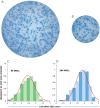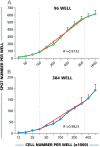ELISPOT Assays in 384-Well Format: Up to 30 Data Points with One Million Cells
- PMID: 25643292
- PMCID: PMC4381210
- DOI: 10.3390/cells4010071
ELISPOT Assays in 384-Well Format: Up to 30 Data Points with One Million Cells
Abstract
Comprehensive immune monitoring requires that frequencies of T cells, producing different cytokines, are measured to establish the magnitude of Th1, Th2, and Th17 components of cell-mediated immunity. Antigen titration provides additional information about the affinity of T cell response. In tumor immunity, it is also advisable to account for determinant spreading by testing multiple epitopes. Efforts for comprehensive immune monitoring would require substantial numbers of PBMC to run the above tests systematically, which in most test cases is limiting. Immune monitoring with ELISPOT assays have been performed, thus far, in a 96-well format. In this study we show that one can increase cell utilization by performing the assay in 384-well plates whose membrane surface area is one third that of 96-well plates. Systematic testing of PBMC for antigen-specific T cell response in the two formats demonstrated that the 384-well assay corresponds to a one-in-three miniaturization of the 96-well assay. The lowest number of cells that can be used in the 384-well format, while allowing for sufficient contact with APC, is 33,000 PBMC/well. Therefore, with one million PBMC typically obtained from 1 mL of blood, a 30 well T cell ELISPOT assay can be performed in a 384-well format.
Figures







References
-
- Lehmann P.V., Sundararaman S. When results of T-cell immune monitoring match/do not match clinical outcomes of tumor vaccine trials: What more could and should we measure? In: Shurin M.R., Umansky V., Malyguine A., editors. The Tumor Immunoenvironment. Springer Dordrecht; New York, NY, USA: 2013. pp. 725–740. Chapter 32.
LinkOut - more resources
Full Text Sources
Other Literature Sources

